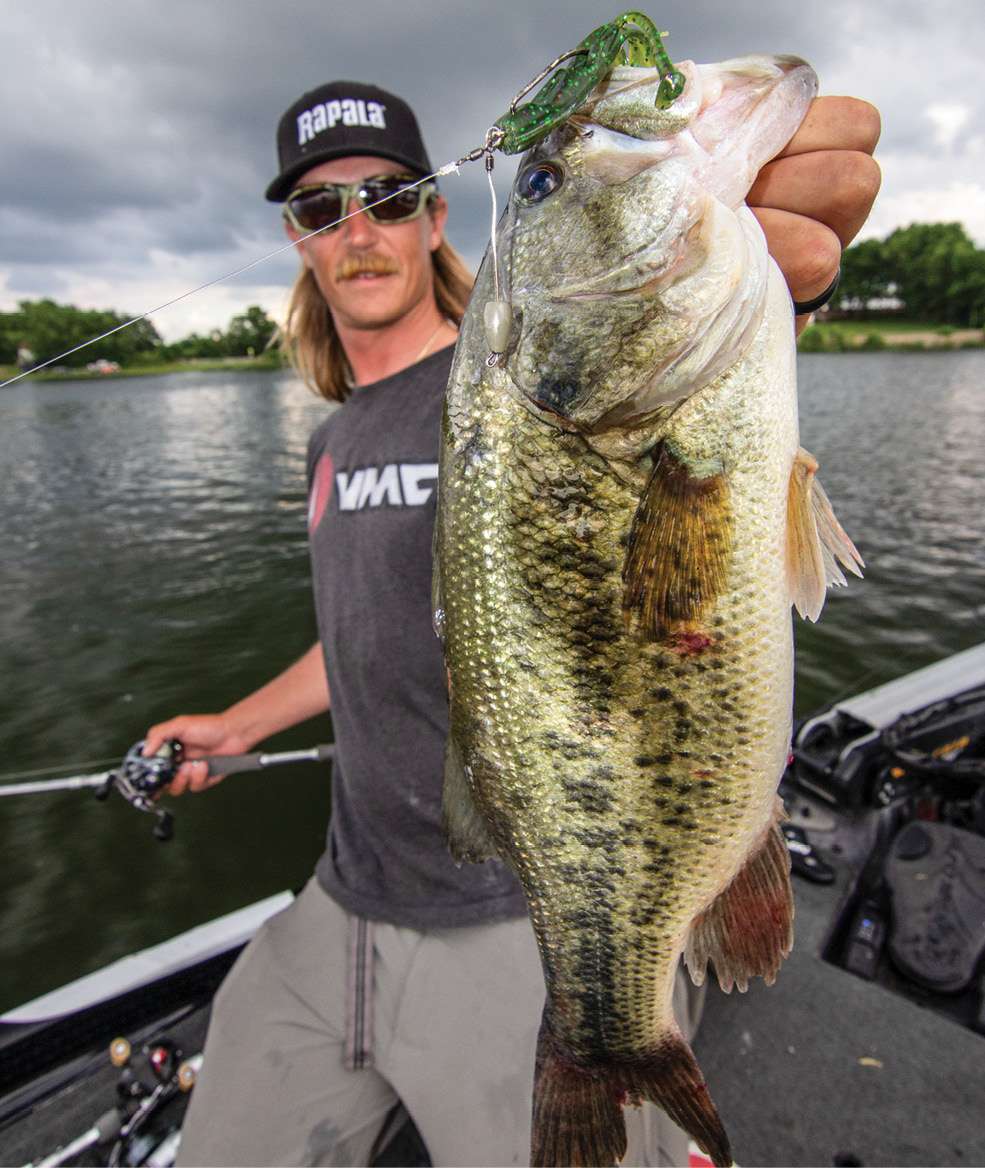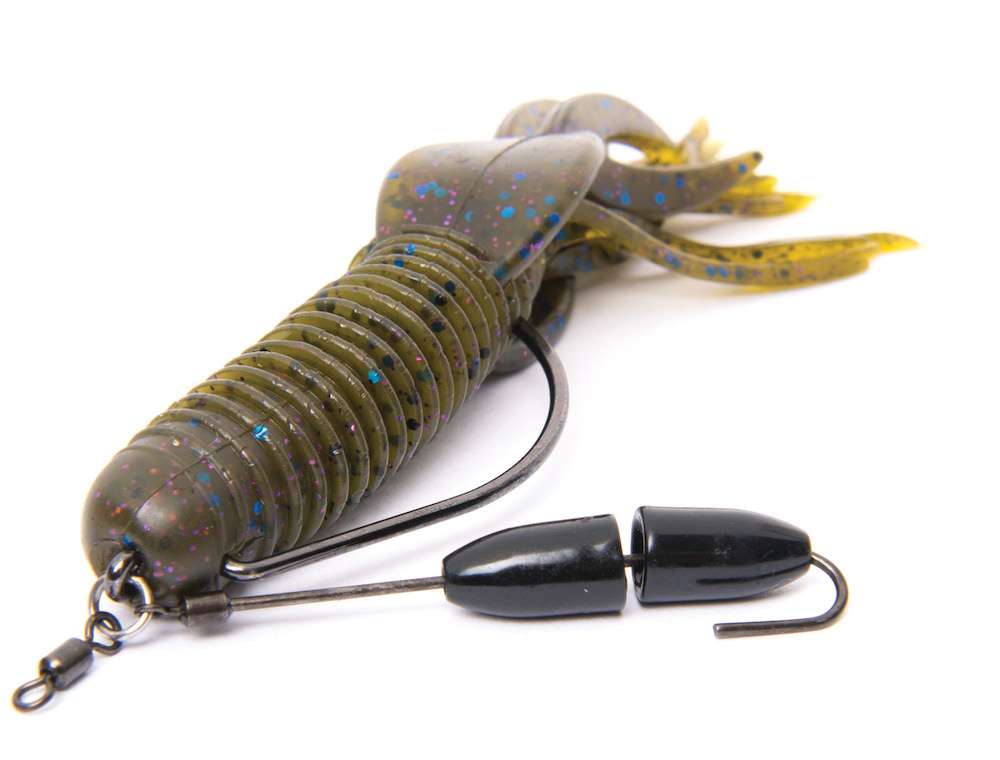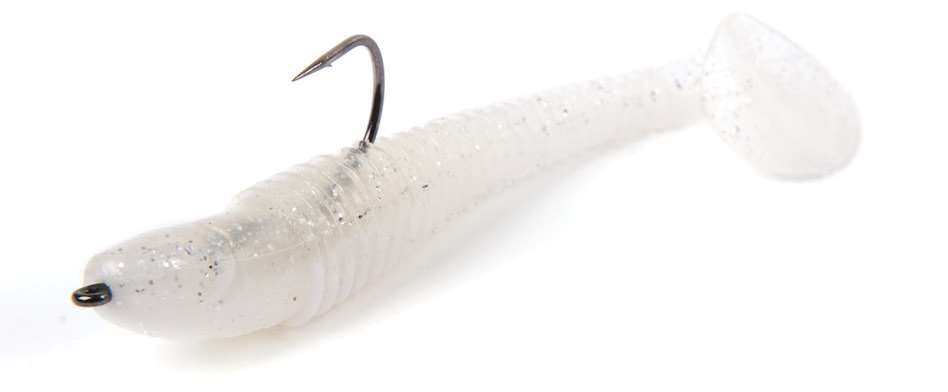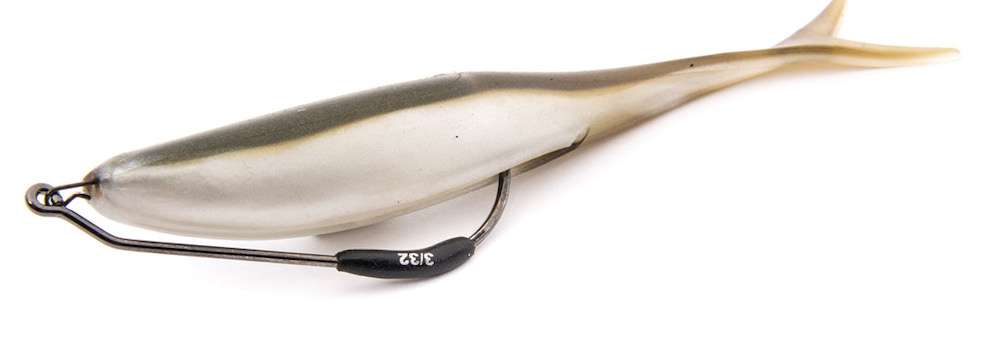
When I became immersed in bass fishing back in the early 1970s, it seemed that we had plenty of techniques to learn in our attempts to fool Mr. Bass. For soft plastics, you could use the deadly Texas rig, which has sure stood the test of time, thanks to its versatility and ability to fish through the thickest cover. The Carolina rig was a whole different animal, but all who learned to adjust their sinker selection and leader length found it deadly on structure or flats without thick cover. It became a fixture in the pros’ arsenal, even if they dread spending the day “draggin’.”
Then some offbeat angler got the nerve to hook a plastic worm through the middle, and the wacky worm was born. I first encountered it at a B.A.S.S. Federation tournament on Cayuga Lake, New York, in the late 1970s. I chuckled as my partner hooked a 6-inch Mann’s Jelly Worm through the egg sac. But when he skipped it under docks and boated several good keepers, I got really interested. He kindly offered to share, and I joined the action. He referred to the odd setup as a Helderberg rig, after a Federation club in the Albany region. It also became known as a “twink” worm, as the bait could be retrieved with sharp rod snaps, or twinks, that caused the two ends to rapidly flex. Club member Brian Rayle used it at the 1980 Bassmaster Florida Invitational on the St. Johns River to finish in the Top 10. Bassmaster’s report dubbed it “Rayle’s rig” in a sidebar to the tournament report, though some sources referred to it somewhat disparagingly as a “Yankee rig.”

Today, one of the hot rigs is the Neko rig, a fancy form of the wacky worm. It involves the use of a weight in one end of the worm, which gives it a unique fall. Years ago, anglers used to stick finishing nails or short screws in the tail of worms to increase drop speed and to alter the action on the fall. Today, several companies offer specially designed Neko weights equipped with barbs to keep the bait from being lost on a cast or strike. With a weight in the tail and the hook placed about 2/3 of the way toward the head end of the worm on an O-ring, a Neko rig glides backward on slack line. When a bass approaches a worm and it suddenly moves toward the fish, it generally gobbles the bait. This reverse gear also can be used to scoot worms far back under docks. Placing the hook closer to the weighted end changes the action, causing the worm’s tail to rise in the water column, waving about in a tempting manner that’s hard for finicky bass to pass up. It’s also deadly for bed fishing as the tail stands upward, teasing the guardian bass into striking. Neko riggers vary in their preference for hook position and weighting, but the versatility of the setup stands out, as it can offer several different postures on the fall and on the bottom.
Like many rigs that have come along, the exact origins of the Texas and Carolina rigs are shrouded in mystery. I’ve heard several differing accounts of Texas anglers and Carolinians credited with being the first to rig soft baits in these manners. This aspect of rigging history continues today with few exceptions. Several recent rigging revelations came from Japan, but the evidence often stops there, perhaps lost in a lack of accurate translation. One notable exception to that trend is the hottest rig today, the Ned rig, which has humble origins, having been crafted by former fishing guide and outdoor writer Ned Kehde of Lawrence, Kan. Over many years, he and his companions toiled in relative obscurity to fine-tune finesse tactics to fool as many bass as possible in the Midwest reservoirs they fished. Their goal was to crack the century mark in bass catches in a four-hour trip, a feat they often accomplished.
Today, many top pros have added the Ned rig to their arsenal, typically reserving it for times when bites are extremely tough to come by, due to weather, moody bass or fishing pressure. Many rod companies have added “Ned rig” rods to their lineups, designing them for the light-line application of fishing little mushroom-head jigs with various soft baits and making them available in sensitive new graphite blends. This is rather ironic, since Kehde and his cronies typically relied on inexpensive, older rods and basic spinning reels for their outings. For decades, Kehde used a light-power Shakespeare 6-foot rod and vintage Zebco Cardinal 4 reel, and he refers to their approach as “frugal fishing,” especially given the longevity of Z-Man baits. He and other Midwestern finesse aficionados lately have been fishing even shorter rods, under 5.5 feet, for best results.

East meets West
Though Norio Tanabe and Takahiro Omori had made their mark in bass tournaments, most American anglers had only hazy notions about Japanese fisheries and tactics until Kota Kiriyama burst onto the scene at the 2000 Bassmaster Classic on Lake Michigan with a rig he called a down-shot rig, which he used to finish fourth, while Californian Mark Rizk was runner-up behind Woo Daves using the same setup, which he’d learned about in Western circles where the rig first caught on. This Japanese import has become a key tool for deep-water finesse fishing and more, as it ensures quick bottom contact while keeping a soft bait hovering above. It opened the doors to more Japanese anglers who shared their riggings after demonstrating how effective they were in tournament competition.
The Tokyo rig
Bassmaster Elite Series pro Patrick Walters of South Carolina has quickly shown he belongs at the highest level of bass competition with a great rookie season on the tour. As a Rapala/VMC pro staffer, he was
introduced to VMC’s Tokyo rig at a pro staff meeting in 2018. He was dubious at first about the clunky-looking setup but tossed some in his boat. He tried it on the St. Johns River in Florida last February at the first Elite event of the season. “I was working areas with mixed pennywort and lily pads and tried flipping a Tokyo rig with a 5/8-ounce weight and a Zoom Speed Worm. I saw a giant on a bed and tried drop shots and a wacky worm to get her to bite, to no avail. But she smashed that Tokyo rig on the first cast!” The lunker weighed 11.28 pounds and needless to say, that was all the convincing Walters needed. He parlayed that pattern to a fourth-place showing in his first Elite event.
“This setup is amazingly versatile,” he proclaims. “It’s great for punching through thick vegetation with a pair of 3/4-ounce tungsten weights attached. I use it with a 1/2-ounce tungsten weight for spotted bass holding in brushpiles to 25 to 30 feet of water. On a Tokyo rig, swimbaits hold close to the bottom and come through the branches easily, unlike an ordinary Texas rig, shaky head or drop-shot rig. I count it down and slowly reel it. The hanging sinker creates a keel effect that keeps swimbaits running perfectly. And it’s easy to clip on a small spinner blade to add flash.”
The rig’s components are key to its versatility, as an angler can slip any weight onto the 2.5-inch wire that hangs below the hook, then bend it to secure a sinker or two. Change weights with the twist of your pliers. Because the sinker isn’t adjacent to the lure, as with a Texas rig, hook sets are surer. In some cases, when a bass bites a Texas rig, it clamps down its jaws on the sinker, preventing a solid hook set. Another advantage is that whatever lure you use is free to pivot on the hook above as the rig falls or bumps along, unlike a Texas rig that’s pinned to the bottom.
Bassmaster Elite Series pro Seth Feider of Minnesota also is a fan. “I’ve won tournaments on it,” Feider reports, “as it can’t be beat for flippin’ deep milfoil, hydrilla and other thick vegetation from the postspawn through summer. Because of the way it falls, you can get away with a lighter sinker, often a 3/8-ounce weight instead of 3/4-ounce or more. It slithers through vegetation much easier than a Texas rig or a jig. And the increased action of your lure means you catch more bass where fishing pressure is high. At times, I drop it through the grass, then shake it like a drop-shot rig, as the bait is above bottom and more visible to bass. I usually match it with a craw tube or a Biospawn Vile Craw in those situations.”
The origins of the Tokyo rig are Japanese, as the name suggests. It reportedly gained fame on the waters of Lake Biwa, where the world-record-tying bass was caught. It seems to be a derivative of the Jika rig, which appeared around 2009. In that setup, the weight hangs from a split ring that also holds the eye of the hook, giving more movement to the lure. But the Tokyo rig separates the lure from the weight by a greater distance, giving it freer movement and surer hook sets. At the 2019 ICAST show last July, VMC introduced a couple of new wrinkles on this setup, offering a Heavy Duty Flippin’ hook version in 3/0, 4/0 and 5/0 sizes and one with a Heavy Duty Worm hook in place of the offset-shank wide-gap hook of the original.

Tokyo rig – The Details
The Tokyo rig pictured here includes two tungsten bullet weights positioned with the flat sides together to help penetrate dense vegetation. Seth Feider’s preferred soft plastic for this rig, the Big Bites Bait Craw Tube, is threaded on the wide-gap hook.
The Tiny Child Rig
Unlike the many rigs that have arisen from the tinkerings of pro anglers or tackle designers, some are the result of imaginative anglers facing a need for something that’s not available. Outdoor writer and editor for Wired2Fish Kyle Peterson represents such a case. He lives in Grand Rapids, Minn., home to countless top-notch lakes for largemouth and smallmouth bass. Many of these waters were used by loggers of yore to transport giant pine trees to the Mississippi River and then points south. Today, the waterlogged timber represents a common form of cover. As a veteran scuba diver, Peterson has observed how bass, as well as walleye and other species, live around and under this gnarly cover. And he’s found that most “weedless” setups hang up way too much.
His solution was the Tiny Child Rig, sometimes shortened to the cryptic “TCR” to keep it as much of a secret as possible in today’s media-savvy world. “It’s quite simply the most weedless thing you can throw,” Peterson notes, “so it’s deadly in many situations that are unfishable with standard presentations. I make it with a 2.75-inch Z-Man Finesse TRD or other bait impaled on a No. 1 VMC Finesse Neko hook that goes in the tail end of the lure, with a 1/8- or 3/16-ounce VMC Half Moon Wacky Weight in the head end. That hook is light wire and has an adjustable fluorocarbon keeper to hold the lure in place. You never miss a fish. To get the sinker into the stretchy ElaZtech material, however, you have to first insert the barbed weight a couple of times to create a hole in the worm. Then apply superglue to the sinker, insert it back in and hold it while the glue sets. It takes some time to rig properly, so I make a bunch before each tournament. I’ve also tied mono around the head end of the worm to hold the weight in place, as the line digs into the ElaZtech and catches on the weight’s barbs. I’ve had a lot of success rigging the Hula StickZ and Big TRD this way for a larger profile that’s equally snag-free.”
Dan Quinn, field promotions director at Rapala, has also been using this rig for fishing tough cover like beaver lodges, riprap and dense, fallen trees. “It doesn’t snag,” he affirms. “That also means it’s the best lure to introduce kids to bass fishing. It won’t snag and no hook set is needed. Just start reeling and the bass is hooked. It also casts easily on light spinning or spincast tackle. It works anywhere — shallow, deep or in current.”

TCR – The Details
The Tiny Child Rig, also known as the TCR, is about as snag-proof as an artificial offering can be. Plus, it is simple to use, hence the name. As you can see in the photo, you simply Texas rig a Z-Man TRD with a small Neko hook on one end, and add a half-moon nail weight to the other. To get the weight to stay in the specialized plastic, you likely will need to use some superglue.
The Tumble rig
Quinn has discovered another oddball method he calls the Tumble rig. “This one is very specialized, unlike the versatile TCR,” he says, “but in rivers in winter, it can out-fish anything else. River smallmouth often flock to warm-water discharges in winter. The water near the outflow often is shallow and fast, but it may be 20 or more degrees warmer than other parts of the system. Contrary to what you might expect, bass are looking upward to feed, apparently to eat suckers, shad and other baitfish that might be stunned by cold temperatures. Local anglers fish live baitfish and baitfish that may fall off the hook or are discarded.
“I rig a small swimbait like a Keitech Swing Impact Fat or VMC Largo Shad on a VMC Finesse Neko hook. You could also use a Fluke or other fork-tail bait. Thread the hook through the lure so the point comes out the back and is exposed. The lure drifts in current, so it won’t snag. Don’t reel; merely let it drift and tumble in the current. When a bass bites, start reeling and he’s hooked. The best action is on a warming trend in winter, which seems to increase bass’ activity level, as well as making it more tolerable to be on the water.” Quinn has shared this secret rig with several pro anglers who have been amazed by its effectiveness.
Since the days of Isaac Walton, inventive anglers have tried to figure out more effective and efficient ways to catch fish. Given the legions of sophisticated bass anglers today, it’s hard to predict what new rigging trend may come along in the coming years. But we’re sure to marvel at its effectiveness and wonder why we didn’t think of it first.

Tumble rig – The Details
The Tumble rig is not built for every situation. However, when you are fishing fast current in the winter, especially during a shad die-off, it will outfish everything else in your tacklebox. As you can see in this photo, the setup is simple. Use either a paddletail swimbait or fluke-style plastic and run a Neko hook through its topside. Simply cast upcurrent and let the drift do the rest.

The Dangle Berry rig
While most rigs are intended for fishing worms, craws, swimbaits and other deeper presentations, Lee Sisson of Winter Haven, Fla., former lure designer for Bagley Bait Co., devised the Dangle Berry rig for use with Zoom Super Flukes and similar baits. It consists of a 4/0 offset Mustad hook with a free-sliding weight on the shank. Sisson claimed not to know the precise weight of the sliding lead but figured it at 3/16 ounce. He reported that this rig garnered him a spot in the 2011 Bassmaster Elite Series, where he became the oldest “rookie” on this tour in history.
During a cast, the weight slides toward the bend of the hook, which facilitates casting. After it lands, Sisson recommends retrieving it like a wacky jig. He allows it to slowly sink, and as it does, the weight slides forward, giving it a horizontal fall with a shimmying or fluttering action that imitates an injured baitfish. Once it reaches bottom, he may deadstick it or lift it a foot or two off bottom, then allow it to fall back. Sisson has retired from tournament competition and no longer sells his rigs. But VMC’s Drop Dead hook was designed to imitate this action and horizontal fall, and anglers also have fashioned their own versions with split shot.
Originally published in Bassmaster Magazine 2019.




